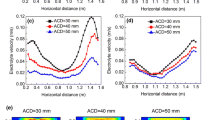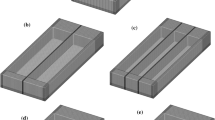Abstract
Based on the commercial computational fluid dynamics software CFX-4.3, electrolyte flow fields in a 156 kA pre-baked anode aluminum electrolysis cell were investigated in three different cases where the electrolyte melt was driven by different kinds of force, i.e. electromagnetic force only, the anode gas drag force only and both of the former two forces. The results show that when electromagnetic force was introduced only, most of the electrolyte moves horizontally; when anode gas drag force was introduced only, the electrolyte flows mainly around each anode with small circulation; when electromagnetic force and anode gas drag force were both introduced together, the structure of the electrolyte flow fields and the velocity of electrolyte are similar to that of the case where only anode gas drag force is used. The electrolyte flow fields are mainly determined by the anode gas drag force.
Similar content being viewed by others
References
MEI Chi. Simulation and optimization of the nonferrous metallurgy furnaces [M]. Bei**g: Metallurgical Industry Press, 2001. (in Chinese)
Bilek M M, Zhang W D, Stevens F J. Modeling of electrolyte flow and its related transport processes in aluminum reduction cells[C]// 123th TMS Annual Meeting, Light Metals. Warrendale: AIME, 1994: 323–331.
ZHOU Li-xing. Fluid mechanics of multi-phase turbulent reaction[M]. Bei**g: National Defence Industry Press, 2002. (in Chinese)
Solheim A, Johansen S T, Rolseth S, et al. Gas driven flow in Hall-Heroult cells[C]// 118th TMS Annual Meeting, Light Metals. Warrendale: AIME, 1989: 245–252.
JIANG Chang-wei, MEI Chi, ZHOU Nai-jun, et al. Computation of 3D magnetic field in pre-baked cells using scalar voltage potential method and two scalar magnetic potentials method[J]. The Chinese Journal of Nonferrous Metals, 2003, 13(4): 1021–1025. (in Chinese)
ZHOU Nai-jun, MEI Chi, JIANG Chang-wei, et al. Coupled computation method of physics fields in aluminum reduction cells [J]. Transactions of Nonferrous Metals Society of China, 2003, 13(2): 431–437.
Lympany S D, Ziegler D P, Evans J W. The Hall-Heroult cell some design alternatives examined by a mathematical model[C]// 112th TMS Annual Meeting, Light Metals. Warrendale: AIME, 1983: 507–517.
Lee H C, Evans J W. Physical model for electromagnetically driven flow in hall cells[C]// 114th TMS Annual Meeting, Light Metals. Warrendale: AIME, 1985: 569–579.
Evans J W, Banerjee S K. A physical model for melt flow in Hall cells[C]// 115th TMS Annual Meeting, Light Metals. Warrendale: AIME, 1986: 535–539.
HUANG Jun, WU Jian-kang, YAO Shi-huan. The numerical simulation on magnetohydrodynamic flow in aluminum reduction cells [J]. Coloured Smelt, 2002, 12(6): 60–62. (in Chinese)
Fraser K J, Taylor M P, Jenkin A M. Electrolyte heat and mass transport processes in Hall-Heroult electrolysis cells[C]// 119th TMS Annual Meeting, Light Metals. Warrendale: AIME, 1990: 221–226.
Purdie J M, Bilek M, Taylor M P, et al. Impact of anode gas evolution on electrolyte flow and mixing in aluminum electrowinning cells[C]// 122th TMS Annual Meeting, Light Metals. Warrendale: AIME, 1993: 355–360.
Author information
Authors and Affiliations
Corresponding author
Additional information
Foundation item: Project (G1999064903) supported by the National Key Fundamental Research and Development Program of China
Rights and permissions
About this article
Cite this article
Zhou, Nj., **a, Xx. & Bao, Sz. Effect of electromagnetic force and anode gas on electrolyte flow in aluminum electrolysis cell. J Cent. South Univ. Technol. 13, 496–500 (2006). https://doi.org/10.1007/s11771-006-0075-8
Received:
Accepted:
Published:
Issue Date:
DOI: https://doi.org/10.1007/s11771-006-0075-8
Key words
- aluminum electrolysis cells
- electrolyte flow fields
- electromagnetic force
- anode gas
- numerical simulation




